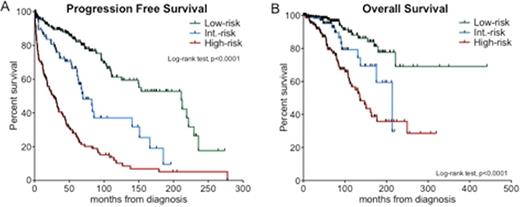Abstract
BACKGROUND
Chronic Lymphocytic Leukemia (CLL) is one of the most common hematological malignancies in Western countries. The disease is characterized by heterogeneous clinical course and outcome. During the last 15 years several clinical, biological and molecular prognostic factors have been identified, validated and some of them are currently used in patients' and treatment management. To improve the predictive accuracy of these markers, they have been combined into prognostic indexes (W. Wierda, JCO 2011, D. Rossi, Blood 2012, J. Bahlo, Haematologica 2015). Werecently proposed the Integrated CLL Scoring System (ICSS) based on cytogenetic abnormalities by FISH, IGHV mutational status and CD38 expression from 212 patients (A. Visentin et al, Clin Lymph Myeloma & Leuk 2015).
The aim of this study was to validate the prognostic power of our index into a larger series of 420 CLL patients.
METHODS
420 CLL patients referred to the Hematology Unit of Padua University Hospital from 1989 to 2015 were recruited in this study. According to ICSS, patients were classified as: low-risk, those patients with 13q deletion or normal FISH, IGVH mutated and CD38<30%; high-risk, subjects with 17p or 11q deletion and/or IGVH unmutated and CD38>30%; intermediate-risk, all remaining patients. Treatment free survival (TFS) was calculated as time from diagnosis to treatment (event), death or last known follow-up (censored). Overall survival (OS) was calculated from the date of diagnosis to death for any cause (event) or last known follow-up (censored). TFS and OS were compared with log-rank test and plotted using Kaplan-Meier method. The predictive accuracy of ICSS was evaluated by the Harrel's concordance index (c-index); a value >0.5 implies a good predictive ability.
RESULTS
The median age of our cohort was 62 years; 64% were male and 85% were Binet stage A at diagnosis. Cytogenetic analysis by FISH showed that 41 patients harbored 17p deletion, 50 11q deletion, 236 13q deletion, 44 trisomy 12 and 49 had normal FISH. 236 (56%) patients had IGHV gene homology >98% (i.e. mutated IGHV) and 103 (25%) expressed more then 30% of CD38.
According to ICSS 202 (48%) subjects were classified as low-risk, 83 (20%) intermediate-risk and 135 (32%) high-risk.
After a median follow-up of 81 months, the median TFS for ICSS classes of risk were 211, 70 and 27 months (log-rank test, p<0.0001, Figure 1A). The estimated 10-year TFS were 61%, 37% and 10% for low, intermediate and high-risk patients. The median OS were 213 and 136 months for intermediate and high-risk, while it was not reached for low-risk patients (Log-rank test, p<0.0001, Figure 1B). After 10 years from diagnosis the estimated OS were 88%, 79% and 57%, respectively. These data were confirmed by a multivariate analyses. In fact, high-risk patients had 5.3 and 4.0 times risk of start treatment and death than low-risk subjects, respectively (p<0.0001). This model was statistically internally validated, showing c-indexed of 0.712 and 0.693 for TFS and OS, respectively.
In multivariate analyses, variables confirmed to predict adverse prognosis were male gender (p=0.0183), age>65years (p<0.0001), Rai III-IV (p=0.0025), Binet C (p=0.0002), 17p deletion (p=0.0002), TP53 abnormalities (p=0.0051), unmutated IGVH (p<0.0001), CD38>30% (p=0.0044) and high-risk ICSS (p<0.0001).
CONCLUSIONS
We herein provide evidence of the prognostic power and feasibility of ICSS into a large population of CLL patients. The use of this prognostic index could help physician into follow-up schedule, since high-risk patients should be monitored more often given the estimated increased risk of progression.
No relevant conflicts of interest to declare.
Author notes
Asterisk with author names denotes non-ASH members.


This feature is available to Subscribers Only
Sign In or Create an Account Close Modal